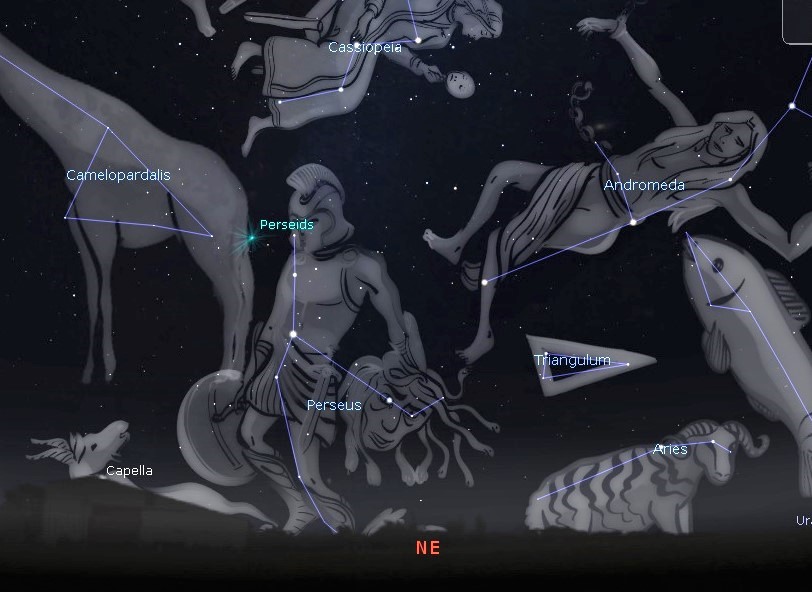This Week’s Sky at a Glance, 2020 August 8 – 15 ~by Curt Nason
The main event in the sky this week is the Perseid meteor shower. You can see a few meteors per hour any night in a clear, dark sky, but the number increases greatly when Earth passes through a trail of pebbles and dust left by a comet that makes frequent orbits around the Sun. The pebbles left by comet 109P/Swift-Tuttle in its 133 year orbit are quite large at a few centimetres, and they enter our atmosphere at a high relative velocity of 60 km/s (Earth travels at 30 km/s). Therefore, they can be very bright. The Perseids will seem to be coming from a point between the constellations Perseus and Cassiopeia, which are at their highest in early morning. You will see fewer in the evening but they tend to be long and bright.
Meteors, also called shooting stars or falling stars, are the streaks of light created when pebbles enter the atmosphere at an altitude of about 100 kilometres, and those particles from comets disintegrate before they reach an altitude of 50 kilometres. Many meteors are faint and easily made invisible by moonlight and light pollution. This year the Perseid shower occurs near the third quarter Moon phase, which rises after midnight and will interfere somewhat with the morning viewing.
Although a dark sky is preferred for watching meteors, many can still be enjoyed from an urban or suburban area. Get comfortable in a chair, have extra clothes or blankets if you plan to stay long as it can get very chilly, and select a patch of sky that is free of clouds and light. It is better to keep Perseus to your side rather than look in that direction because the meteors will look more spectacular, covering a longer distance. Under ideal conditions one might see 60-100 Perseids, but be very happy if you see about 20-30 per hour on the peak night or fewer a day before or after.
This Week in the Solar System
Saturday’s sunrise in Moncton is at 6:10 am and sunset will occur at 8:38 pm, giving 14 hours, 28 minutes of daylight (6:17 am and 8:41 pm in Saint John). Next Saturday the Sun will rise at 6:19 am and set at 8:27 pm, giving 14 hours, 8 minutes of daylight (6:25 am and 8:30 pm in Saint John).
The Moon passes below Mars this Sunday morning and it is at third quarter on Tuesday. Jupiter and Saturn are at their best for observing in late evening. Telescope users might see Jupiter’s Red Spot around 10 pm Monday and 11:30 pm on Wednesday, while Saturn’s rings are a memorable sight. Mars rises around 11 pm and offers telescopic views of its south polar ice cap. Venus is at its greatest elongation from the Sun on Wednesday, and Mercury has moved too close to the Sun to be observed. The Perseid meteor shower is at its best on the night of August 11/12 but the nights before and after will also be rewarding if the weather cooperates.
With astronomy meetings and outreach activities on hold, you can watch the local Sunday Night Astronomy Show at 8 pm and view archived shows.
Questions? Contact Curt Nason.

